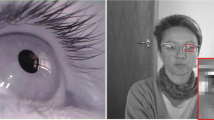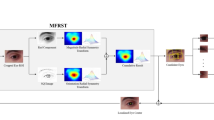Abstract
Accurate localization of eyes in low-resolution facial images is a challenging problem in computer vision community. The existing techniques provides inaccurate results for eye center localization in an uncontrolled environment, e.g. low resolution, low contrast, scale, pose and illumination variations etc. This study proposes a hybrid method for accurate eye center localization which shows robustness to above-mentioned problems. The proposed hybrid method is a two stage method. In the first stage, a new operator based on gradient and intensity information is proposed to extract the coarse eye candidates. The proposed operator uses the integral image and the dot product operations that make the system computationally efficient. The likelihood of eye centers are further verified in the second stage using a convolutional neural network architecture. In the verification stage, the normalized region of interest is adopted to solve the variations of different scales. The eye pair satisfying the predefined constraints is selected as the true eye pair. The proposed method is extensively tested on various databases to check its accuracy to the uncontrolled environment. The experimental analysis suggests that the proposed hybrid method can localize the eye center more precisely and eventually shows superior performance over some of the competitive state-of-the-art methods.


















Similar content being viewed by others
References
Abiyev RH, Arslan M (2019) Head mouse control system for people with disabilities. Expert Syst 3:e12398
Ahmed NY (2021) Real-time accurate eye center localization for low-resolution grayscale images. J Real-Time Image Proc 18(1):193–220
Ahmed M, Laskar RH (2019) Eye center localization in a facial image based on geometric shapes of iris and eyelid under natural variability. Image Vis Comput. https://doi.org/10.1016/j.imavis.2019.05.002
Ahmed M, Laskar RH (2019) Eye detection and localization in a facial image based on partial geometric shape of iris and eyelid under practical scenarios. J Electron Imaging 28(3):033009. https://doi.org/10.1117/1.JEI.28.3.033009
Ahmed M, Laskar RH (2021) Evaluation of accurate iris center and eye corner localization method in a facial image for gaze estimation. Multimed Syst. https://doi.org/10.1007/s00530-020-00744-8
Alonso-Fernandez F, Bigun J (2016) A survey on periocular biometrics research. Pattern Recogn Lett 82:92–105
Asadifard M, Shanbezadeh J (2010) Automatic adaptive center of pupil detection using face detection and CDF analysis, In: Proceedings of the International Multiconference of Engineers and Computer Scientists, vol 1, p 3
Baek SJ, Choi KA, Ma C, Kim YH, Ko SJ (2013) Eyeball model-based iris center localization for visible image-based eye-gaze tracking systems. IEEE Trans Consum Electron 59(2):415–421
BF Database. Dataset for face detection, Facedb - BioID, https://www.bioid.com/facedb/. Google Scholar
Borza D, Darabant AS, Danescu R (2016) Real-time detection and measurement of eye features from color images. Sensors 16(7):1105
Chen S, Liu C (2015) Eye detection using discriminatory Haar features and a new efficient SVM. Image Vis Comput 33:68–77
Choi JH, Lee KI, Song BC (2020) Eye pupil localization algorithm using convolutional neural networks. Multimed Tools Appl 79(43):32563–32574
Cootes TF, Taylor CJ, Cooper DH (1995) Graham J (1995) Active shape models-their training and application. Comput Vis Image Underst 61(1):38–59
Cootes TF, Edwards GJ, Taylor CJ (2001) Active appearance models. IEEE Trans Pattern Anal Mach Intell 23(6):681–685
Cristinacce D, Cootes TF (2006) Feature detection and tracking with constrained local models. In Bmvc, vol 1, no. 2, p 3
Daugman J (2009) How iris recognition works. In: The essential guide to image processing, pp 715–739
Drewes H (2014) Eye gaze tracking. Interactive displays: natural human interface technologies, pp 251–283
Duchowski AT (2007) Eye tracking methodology. Theory and practice, p 328
Farkas LG, Katic MJ (2005) Forrest CR, International anthropometric study of facial morphology in various ethnic groups/races. J Craniofac Surg 16(4):615–646
Fasel I, Fortenberry B, Movellan J (2005) A generative framework for real-time object detection and classification. Comput Vis Image Underst 98(1):182–210
Gao W, Cao B, Shan S, Chen X, Zhou D, Zhang X, Zhao D (2008) The CAS-PEAL large-scale Chinese face database and baseline evaluations. IEEE Trans Syst Man Cybern A Syst Hum 38(1):149–161
George A, Routray A (2016) Fast and accurate algorithm for eye localization for gaze tracking in low-resolution images. IET Comput Vision 10(7):660–669
Gross R, Matthews I, Cohn J, Kanade T, Baker S (2010) Multi-pie. Image Vis Comput 28(5):807–813
Hamouz M, Kittler J, Kamarainen JK, Paalanen P, Kalviainen H, Matas J (2005) Feature-based affine-invariant localization of faces. IEEE Trans Pattern Anal Mach Intell 27(9):1490–1495
Hassaballah M, Kandazawa T, Ido S (2010) Efficient eye detection method based on grey intensity variance and independent components analysis. IET Comput Vision 4(4):261–271
Hsu WY, Chung CJ (2021) A novel eye center localization method for multiview faces. Pattern Recognit 119:108078
Ito Y, Ohyama W, Wakabayashi T, Kimura F (2012) Detection of eyes by circular Hough transform and histogram of gradient. In: Pattern Recognition (ICPR), 21st IEEE International Conference, pp 1795–1798
Jain AK (1989) Fundamentals of digital image processing. Prentice Hall, Englewood Cliffs
Jariwala KN, Nandi A, Dalal UD (2015) A real-time robust eye center localization using geometric eye model and edge gradients in unconstrained visual environment. Int J Comput Appl 128(1):22–27
Jesorsky O, Kirchberg KJ, Frischholz RW (2001) Robust face detection using the Hausdorff distance. In: International Conference on audio-and video-based biometric person authentication. Springer, Berlin, pp 90–95
**g MQ, Chen LH (2010) A novel method for horizontal eye line detection under various environments. Int J Pattern Recognit Artif Intell 24(03):475–498
Jo J, Lee SJ, Park KR, Kim IJ, Kim J (2014) Detecting driver drowsiness using feature-level fusion and user-specific classification. Expert Syst Appl 41(4):1139–1152
Jo J, Choi H, Kim IJ, Kim J (2015) Single-view-based 3D facial reconstruction method robust against pose variations. Pattern Recogn 48(1):73–85
Kim BS, Lee H, Kim WY (2010) Rapid eye detection method for non-glasses type 3D display on portable devices. IEEE Trans Consum Electron 56(4):2498–2505
Kim H, Jo J, Toh KA, Kim J (2017) Eye detection in a facial image under pose variation based on multi-scale iris shape feature. Image Vis Comput 57:147–164
Krizhevsky A, Sutskever I, Hinton GE (2012) Imagenet classification with deep convolutional neural networks. In Advances in Neural Information Processing Systems, pp 1097–1105
Kroon B, Maas S, Boughorbel S, Hanjalic A (2009) Eye localization in low and standard definition content with application to face matching. Comput Vis Image Underst 113(8):921–933
LeCun Y, Bottou L, Bengio Y, Haffner P (1998) Gradient-based learning applied to document recognition. Proc IEEE 86(11):2278–2324
Leo M, Cazzato D, De Marco T, Distante C (2014) Unsupervised eye pupil localization through differential geometry and local self-similarity matching. PLoS ONE 9(8):e102829
Levinshtein A, Phung E, Aarabi P (2018) Hybrid eye center localization using cascaded regression and hand-crafted model fitting. Image Vis Comput 71:17–24
Liu ZT, Jiang CS, Li SH, Wu M, Cao WH, Hao M (2021) Eye state detection based on weight binarization convolution neural network and transfer learning. Appl Soft Comput 109:107565
Markuš N, Frljak M, Pandžić IS, Ahlberg J, Forchheimer R (2014) Eye pupil localization with an ensemble of randomized trees. Pattern Recogn 47(2):578–587
Monzo D, Albiol A, Sastre J, Albiol A (2011) Precise eye localization using HOG descriptors. Mach Vis Appl 22(3):471–480
Morimoto CH, Mimica MRM (2005) Eye gaze tracking techniques for interactive applications. Comput Vis Image Underst 98(1):4–24
Oliveira LS, Borges DL, Vidal FB, Chang L (2012) A fast eye localization and verification method to improve face matching in surveillance videos. IEEE International Conference on Systems, Man, and Cybernetics (SMC), pp 840–845
Ponz V, Villanueva A, Cabeza R (2012) Dataset for the evaluation of eye detector for gaze estimation. In: Proceedings of the 2012 ACM Conference on Ubiquitous Computing, pp 681–684
Ren Y, Wang S, Hou B, Ma J (2014) A novel eye localization method with rotation invariance. IEEE Trans Image Process 23(1):226–239
Savakis A, Sharma R, Kumar M (2014) Efficient eye detection using HOG-PCA descriptor. In Imaging and Multimedia Analytics in a Web and Mobile World 2014, vol 9027, p 90270J. International Society for Optics and Photonics
Skodras E, Fakotakis N (2015) Precise localization of eye centers in low-resolution color images. Image Vis Comput 36:51–60
Song F, Tan X, Chen S, Zhou ZH (2013) A literature survey on robust and efficient eye localization in real-life scenarios. Pattern Recogn 46(12):3157–3173
Tan X, Song F, Zhou ZH, Chen S (2009) Enhanced pictorial structures for precise eye localization under uncontrolled conditions. Computer Vision and Pattern Recognition, IEEE Conference, pp 1621–1628
Timm F, Barth E (2011) Accurate eye centre localisation by means of gradients. Visapp 11:125–130
Valenti R, Gevers T (2012) Accurate eye center location through invariant isocentric patterns. IEEE Trans Pattern Anal Mach Intell 34(9):1785–1798
Viola P, Jones M (2001) Rapid object detection using a boosted cascade of simple features. Computer Vision and Pattern Recognition, Proceedings of the 2001 IEEE Computer Society Conference, vol 1, pp I-I
Wang P, Ji Q (2007) Multi-view face and eye detection using discriminant features. Comput Vis Image Underst 105(2):99–111
Wang J, Sung A, Venkateswarlu R (2003) Eye gaze estimation from a single image of one eye. In: Computer Vision, Proceedings, Ninth IEEE International Conference; pp 136–143
Wang P, Green MB, Ji Q, Wayman, J (2005) Automatic eye detection and its validation. Computer Vision and Pattern Recognition, IEEE Computer Society Conference, 3, pp 164-172
**a Y, Lou J, Dong J, Qi L, Li G, Yu H (2020) Hybrid regression and isophote curvature for accurate eye center localization. Multimed Tools Appl 79(1):805–824
Young D, Tunley H, Samuels R (1995) Specialized Hough transform and active contour methods for real-time eye tracking. University of Sussex, Cognitive & Computing Science
Zhao S, Grigat RR (2006) Robust eye detection under active infrared illumination. In Proceedings of the 18th International Conference on Pattern Recognition, IEEE Computer Society, pp 481–484
Acknowledgements
This research work has been carried out in the department of R&D, CMR College of Engineering & Technology, Hyderabad, India, and in the Speech and Image Processing Lab, NIT Silchar, India, and is supported by Visvesvaraya Ph.D. Scheme of MeitY, Government of India (Ref. No.: PhD-MLA/4(74)/2015-16).
Author information
Authors and Affiliations
Corresponding author
Additional information
Publisher's note
Springer Nature remains neutral with regard to jurisdictional claims in published maps and institutional affiliations.
Rights and permissions
About this article
Cite this article
Ahmed, M., Laskar, R.H. Eye center localization using gradient and intensity information under uncontrolled environment. Multimed Tools Appl 81, 7145–7168 (2022). https://doi.org/10.1007/s11042-021-11805-z
Received:
Revised:
Accepted:
Published:
Issue Date:
DOI: https://doi.org/10.1007/s11042-021-11805-z




